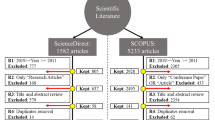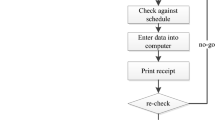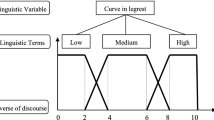Abstract
Product personalization, a popular topic of Industry 4.0, requires enterprises to develop customer-centric products in a cost-efficient way. To achieve this goal, a personalized product configuration design that divides a product into multiple modules and instantiates them in parallel has been proposed and proven to be an effective method. However, the complex coupling relationships between component instances and their adaptability to individual requirements directly affect configuration design efficiency and accuracy, which requires reasonable instantiation process planning. Thus, this paper proposes a heuristic process planning method for personalized product configuration design. It first defines the personalized product configuration unit (PPCU) that encapsulates module information and design knowledge, avoiding repeated knowledge retrieval in the instantiation. Using the relevant data contained in the PPCU, a characteristic quantification method (CQM) is proposed to measure the coupling characteristics and adaptability characteristics of the PPCU. Taking characteristic values as input, the proposed heuristic approach, which simulates the crystallization growth process at imbalanced temperatures (ICCP), is applied to configuration design process planning to quickly identify appropriate instantiation sequences. In addition, the novel decoupling strategy we proposed considers the time-coupling ratio and the deformation workload expectation to split the strongly coupled PPCU group. Comprehensive performance experiments on a real dataset and an application experiment on personalized elevator design are conducted. The results verify that our method can achieve the configuration design with the highest planning efficiency and best design configuration result compared to five state-of-the-art methods, especially in the configuration design of complexly structured personalized products.















Similar content being viewed by others
Availability of data and material
All data generated or analyzed during this study are included in this paper.
Code availability
We have provided the relevant Github links in the paper.
References
Berry C, Wang H, Hu SJ (2013) Product architecting for personalization. J Manuf Syst 32(3):404–411
Cai C, Xiao R, Yang P (2010) The method for analysing and disposing of functional interaction in axiomatic design. Proceedings of the Institution of Mechanical Engineers, Part C: Journal of Mechanical Engineering Science 224(2):401–409
Cheng X, Xiao R, Wang H (2018) A method for coupling analysis of association modules in product family design. J Eng Des 29(6):327–352
Chiu CC, Lai CM, Chen CM (2023) An evolutionary simulation-optimization approach for the problem of order allocation with flexible splitting rule in semiconductor assembly. Appl Intell 53(3):2593–2615
Dai Z, Scott MJ (2007) Product platform design through sensitivity analysis and cluster analysis. J Intell Manuf 18:97–113
Dennis A, Wixom BH, Roth RM (2008) Systems analysis and design. John wiley & sons
Dong M, Yang D, Su L (2011) Ontology-based service product configuration system modeling and development. Expert Syst Appl 38(9):11770–11786
Dou R, Zong C, Nan G (2016) Multi-stage interactive genetic algorithm for collaborative product customization. Knowl-Based Syst 92:43–54
Felfernig A, Hotz L, Bagley C, Tiihonen J (2014) Knowledge-based configuration: from research to business cases. Newnes
Haug A, Hvam L, Mortensen NH (2010) A layout technique for class diagrams to be used in product configuration projects. Comput Ind 61(5):409–418
Hossein Nia Shavaki F, Jolai F (2021) A rule-based heuristic algorithm for joint order batching and delivery planning of online retailers with multiple order pickers. Appl Intell 51:3917–3935
Hotz L, Felfernig A, Stumptner M, Ryabokon A, Bagley C, Wolter K, et al. (2014) Configuration knowledge representation and reasoning. PhD thesis, Morgan Kaufmann Amsterdam
Hu SJ, Ko J, Weyand L, ElMaraghy HA, Lien TK, Koren Y, Bley H, Chryssolouris G, Nasr N, Shpitalni M (2011) Assembly system design and operations for product variety. CIRP Ann 60(2):715–733
Kosztyán ZT (2015) Exact algorithm for matrix-based project planning problems. Expert Syst Appl 42(9):4460–4473
Lee CH, Chen CH, Lin C, Li F, Zhao X (2019) Developing a quick response product configuration system under industry 4.0 based on customer requirement modelling and optimization method. Appl Sci 9(23):5004
Lee J, Han S (2010) Knowledge-based configuration design of a train bogie. J Mech Sci Technol 24:2503–2510
Levandowski CE, Jiao JR, Johannesson H (2015) A two-stage model of adaptable product platform for engineering-to-order configuration design. J Eng Des 26(7–9):220–235
Li X, Gao L, Wang W, Wang C, Wen L (2019) Particle swarm optimization hybridized with genetic algorithm for uncertain integrated process planning and scheduling with interval processing time. Comput Ind Eng 135:1036–1046
Liu Q, Li X, Gao L (2021) Mathematical modeling and a hybrid evolutionary algorithm for process planning. J Intell Manuf 32:781–797
McDermott J (1982) R1: a rule-based configurer of computer systems. Artificial intelligence 19(1):39–88
Mittal S, Frayman F (1989) Towards a generic model of configuraton tasks. IJCAI, Citeseer 89:1395–1401
Park J, Shin D (2007) A product platform development method using qfd. International Design Engineering Technical Conferences and Computers and Information in Engineering Conference 48078:949–958
Rogers JL (1990) Knowledge-based tool for decomposing complex design problems. J Comput Civ Eng 4(4):298–312
Shao Z, Shao W, Pi D (2020) Effective constructive heuristic and metaheuristic for the distributed assembly blocking flow-shop scheduling problem. Appl Intell 50:4647–4669
Sharman DM, Yassine AA (2004) Characterizing complex product architectures. Syst Eng 7(1):35–60
Shuyou Z, Wenqi G, Zili W, Lemiao Q, Huifang Z (2021) A heuristic configuration solving process planning method for mechanical product configuration by imitating the crystal crystallization process. Int J Adv Manuf Technol 116(1–2):611–628
Sollow E (1987) Assessing the maintainability of xcqn-in-rime: coping with the problems of a very large rule-base. Proceedings of the sixth National conference on Artificial intelligence 2:824–829
Song Q, Ni Y, Ralescu DA (2021) Product configuration using redundancy and standardisation in an uncertain environment. Int J Prod Res 59(21):6451–6470
Spinner M (1989) Improving project management skills and techniques. Pearson College Division
Su JCY, Chen SJG, Lin L (2003) A structured approach to measuring functional dependency and sequencing of coupled tasks in engineering design. Comput Ind Eng 45(1):195–214
Suh ES, Furst MR, Mihalyov KJ, Weck Od (2010) Technology infusion for complex systems: a framework and case study. Syst Eng 13(2):186–203
Sun L, An J, Yu H (2016) The application of design structure matrix optimization method based on genetic algorithm. 2016 International Conference on Communications. Atlantis Press, Information Management and Network Security, pp 271–273
Tan C, Hu SJ, Chung H, Barton K, Piya C, Ramani K, Banu M (2017) Product personalization enabled by assembly architecture and cyber physical systems. CIRP Ann 66(1):33–36
Tan C, Chung H, Barton K, Hu SJ, Freiheit T (2020) Incorporating customer personalization preferences in open product architecture design. J Manuf Syst 56:72–83
Tirkolaee EB, Aydın NS, Ranjbar-Bourani M, Weber GW (2020) A robust bi-objective mathematical model for disaster rescue units allocation and scheduling with learning effect. Comput Ind Eng 149:106790
Tirkolaee EB, Goli A, Weber GW (2020) Fuzzy mathematical programming and self-adaptive artificial fish swarm algorithm for just-in-time energy-aware flow shop scheduling problem with outsourcing option. IEEE Trans Fuzzy Syst 28(11):2772–2783
Tseng M, Jiao R, Wang C (2010) Design for mass personalization. CIRP Ann 59(1):175–178
Wang P, Gong Y, Xie H, Liu Y (2016) Somedgra: a case retrieval method for machine tool product configuration design. J Mech Sci Technol 30:3283–3293
Yassine A, Falkenburg D, Chelst K (1999) Engineering design management: an information structure approach. Int J Prod Res 37(13):2957–2975
Yu YW, Deng YM, Lu W, Nee A (2015) Analysis of mechanical systems with adaptable functions for the evaluation of functional coupling and component importance. Int J Adv Manuf Technol 76:1449–1458
Zeng F, Jin Y (2007) Study on product configuration based on product model. Int J Adv Manuf Technol 33:766–771
Zhang X, Ma S, Chen S (2019) Healthcare process modularization using design structure matrix. Adv Eng Inform 39:320–330
Zheng P, Xu X, Yu S, Liu C (2017) Personalized product configuration framework in an adaptable open architecture product platform. J Manuf Syst 43:422–435
Zheng P, Yu S, Xu X (2017) A personalized attribute determination process in a cloud-based adaptable product configurator. In: International manufacturing science and engineering conference, American society of mechanical engineers, vol 50749, p V003T04A024
Zhou F, Ji Y, Jiao RJ (2013) Affective and cognitive design for mass personalization: status and prospect. J Intell Manuf 24:1047–1069
Acknowledgements
This work was supported by the National Natural Science Foundation of China (52375271), the Natural Science Foundation of Zhejiang Province (LY23E050011), and Pioneer and Leading Goose R &D Program of Zhejiang (2022C01051).
Funding
All authors certify that they have no affiliations with or involvement in any organization or entity with any financial interest or non-financial interest in the subject matter or materials discussed in this manuscript.
Author information
Authors and Affiliations
Contributions
Conceptualization: Kerui Hu, Lemiao Qiu; Methodology: Kerui Hu; Formal analysis and investigation: Naiyu Fang; Writing - original draft preparation: Zili Wang; Writing - review and editing: Shuyou Zhang; Supervision: Shuyou Zhang.
Corresponding author
Ethics declarations
Consent to Publish
Authors consent to publish this article.
Additional information
Publisher's Note
Springer Nature remains neutral with regard to jurisdictional claims in published maps and institutional affiliations.
Rights and permissions
Springer Nature or its licensor (e.g. a society or other partner) holds exclusive rights to this article under a publishing agreement with the author(s) or other rightsholder(s); author self-archiving of the accepted manuscript version of this article is solely governed by the terms of such publishing agreement and applicable law.
About this article
Cite this article
Hu, K., Qiu, L., Zhang, S. et al. ICCP: A heuristic process planning method for personalized product configuration design. Appl Intell 53, 30887–30910 (2023). https://doi.org/10.1007/s10489-023-05186-z
Accepted:
Published:
Issue Date:
DOI: https://doi.org/10.1007/s10489-023-05186-z








